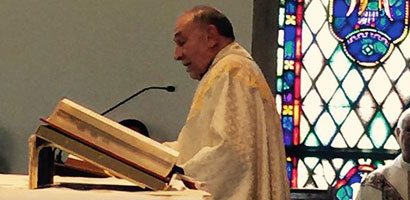 GREENSBORO — Monsignor Joseph Showfety returned to the church of his childhood May 19 to say Mass and give thanks to God for his priestly vocation. The day marked his 60th jubilee of ordination, and the place – St. Benedict Church in Greensboro – was where he had first felt the call to priestly life as a young altar boy.
GREENSBORO — Monsignor Joseph Showfety returned to the church of his childhood May 19 to say Mass and give thanks to God for his priestly vocation. The day marked his 60th jubilee of ordination, and the place – St. Benedict Church in Greensboro – was where he had first felt the call to priestly life as a young altar boy.
Monsignor Showfety is one of the first native priests in the Diocese of Charlotte and served for seven years as its first chancellor.
Pictured: Monsignor Showfety celebrated his 60th anniversary of ordination with Mass May 19 at St. Benedict Church in Greensboro followed by a reception hosted by the Vincent G. Taylor Fourth Degree Assembly 779.(Photo provided by Father Paul Gary)
Growing up the son of devout Lebanese Catholic immigrants Abdou and Edna Showfety, Monsignor Showfety lived just a few blocks away from St. Benedict's, and starting in the third grade at St. Benedict School he began serving 7 a.m. daily Mass. He credits Daughter of Charity Sister Genevieve Riordan and the other women religious who were his teachers, as well as Monsignor Hugh Dolan, pastor, for encouraging his vocation.
Serving at the altar drew him closer to Christ, he recalls, and he thinks it's unfortunate that more children today do not have the same opportunity to attend daily Mass as he once did.
"Priests can be a great, great influence on kids," he notes.
He attended The Citadel in Charleston, S.C., in the final months of World War II and then spent 16 months in the Navy. After service he went to Mount Saint Mary's College (now University) in Emmitsburg, Md., for four years. Bishop Vincent Waters of Raleigh then transferred him to St. Mary's Seminary in Baltimore, the nation's oldest Catholic seminary, to complete his studies. He remains grateful that Bishop Waters moved him to St. Mary's, and he has many fond memories of the rector there, Sulpician Father James Laubacher.
"He was a very good man," he recalls, and had just the right approach in guiding each of the men through their discernment and preparation for the priesthood. No small feat for the rector, when Monsignor Showfety's class alone had 153 men.
During the summers the young seminarian worked in parishes, doing mostly "census work" – visiting parish families' homes and updating the parish rolls. It was grueling work in the summer heat and humidity, he recalls, especially given the black serge cassocks they wore at the time, but he didn't mind.
He was ordained by Bishop Waters on May 19, 1955, along with Father Thomas Clements and the late Father Robert Shea.
He remembers Bishop Waters as a demanding yet fair leader who knew every inch of his North Carolina territory and loved the Church. "He knew the parishes, he knew the priests," he says. "I can never exaggerate the work he did for the Church in this state. It was his goal to have a Catholic presence in every county in the state."
Before he retired in 2002, Monsignor Showfety served in 11 parishes in North Carolina, and nearly everywhere he served he either oversaw new building projects or renovations.
One of his first assignments was at a small parish in eastern North Carolina, he remembers. When he checked the bank account, he found only $1.73, he says with a laugh. When he left the parish for his next assignment a couple of years later, the parish had a couple thousand dollars in the bank, he adds.
Monsignor Showfety also served as director of Our Lady of the Hills Camp, principal of Asheville Catholic High School and director of Bishop McGuinness High School, but it as the first chancellor of the diocese from 1972 to 1979 that the impact of his service still resounds today.
He was one of the first to learn in late 1971 when Bishop Waters told Monsignor Michael Begley that he had petitioned Rome to divide his diocese of 60,000 Catholics and create the Charlotte diocese.
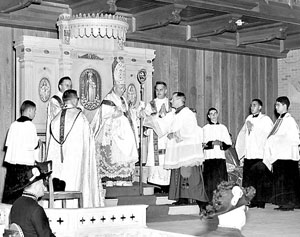 Diocese of Charlotte archive photo Our Lady of Grace Church was dedicated on Sept. 14, 1952, presided over by apostolic delegate Archbishop Amleto Cicognani (center). The priest with his back facing the congregation is Monsignor Hugh Dolan, and behind him is Monsignor Lawrence Newman. Note, second from right, serving as vimp is a young Joseph Showfety of Greensboro, who later became one of the area's first native priests and then rose to serve as the new Diocese of Charlotte's first chancellor when the diocese was established in 1972.The story goes like this: Two days before Thanksgiving 1971, Bishop Waters visited Monsignor Begley in Greensboro, then pastor of Our Lady of Grace Church. Under the guise of looking for property in Greensboro for future parish use, Bishop Waters took the pastor with him. The Raleigh diocese already owned property nearby to relocate Notre Dame High School.
Diocese of Charlotte archive photo Our Lady of Grace Church was dedicated on Sept. 14, 1952, presided over by apostolic delegate Archbishop Amleto Cicognani (center). The priest with his back facing the congregation is Monsignor Hugh Dolan, and behind him is Monsignor Lawrence Newman. Note, second from right, serving as vimp is a young Joseph Showfety of Greensboro, who later became one of the area's first native priests and then rose to serve as the new Diocese of Charlotte's first chancellor when the diocese was established in 1972.The story goes like this: Two days before Thanksgiving 1971, Bishop Waters visited Monsignor Begley in Greensboro, then pastor of Our Lady of Grace Church. Under the guise of looking for property in Greensboro for future parish use, Bishop Waters took the pastor with him. The Raleigh diocese already owned property nearby to relocate Notre Dame High School.
Monsignor Showfety describes what happened next: "Bishop Waters and Monsignor Begley were driving toward the property when the bishop pulled over. 'I'm going to ask you a question. If you say "yes" I'll take it from there. If you say "no" you must never say a word about this conversation to anyone.'
"Intrigued but not surprised by the secrecy, Monsignor Begley wondered what the question was. 'Rome has decided to make Charlotte a diocese with you as the bishop,' said Bishop Waters. 'Do you accept?" The monsignor didn't hesitate and answered, "Yes." Bishop Waters simply put the car in gear and the bishop with the bishop-elect continued down the road."
So how did Monsignor Showfety become the first chancellor?
He recalls that there had been a freak snowstorm in Hendersonville, where he served as pastor at Immaculate Conception Church. He had just come back to the rectory from shoveling a path to the church through the 15 inches of snow. It was a First Friday, Dec. 3, 1971, and he had to prepare to celebrate 11 a.m. Mass. The phone rang.
"It was Bishop-elect Begley calling. I congratulated him and our conversation continued. He said, 'I want you to be chancellor.' My reply was, 'I want to build a new church in Hendersonville.' He replied, 'I know you do. It'll be built, but not by you. I want you in Charlotte.'"
For the next few weeks, Monsignor Showfety traveled back and forth several times to Raleigh to work with the chancellor there, Monsignor Louis Morton. It was the holiday season, but there were only six weeks to set everything up. The date for Bishop Begley's ordination had been set for Jan. 12, 1972, at St. Patrick Cathedral, which was being elevated from its status as a parish church.
Titles for all parish properties and all diocesan vehicles had to be transferred from Bishop Waters to Bishop Begley. It was quite a lot to do for the six men involved: two bishops, two chancellors and two attorneys. Monsignor Showfety spent three days just transferring car titles at the state Department of Motor Vehicles in Raleigh. "The police in that office asked me if I lived there," he remembers with a chuckle.
That excitement and rapid pace set the tone for the new diocese and Monsignor Showfety's role as chancellor, but, he adds, "everything fit in place." The two dioceses worked together through the complex work with warmth and a spirit of brotherhood. Bishop Waters, he recalls, treated the new diocese with generosity and fairness: "He took care of us as much as his own diocese."
A temporary office was set up for the new bishop and the chancellor in a couple of rooms of the rectory at St. Patrick Cathedral by its pastor, Father Richard Allen.
On Jan. 12, 1972, Bishop Begley was ordained, and that night Bishop Waters and Bishop Begley hosted a large dinner at a downtown Charlotte hotel to celebrate.
The next morning, Monsignor Showfety says, "we were open for business."
Neither Bishop Begley nor Monsignor Showfety – then Father Showfety – had any experience for their new jobs, he recalls with a laugh. They had been parish priests and run schools, and Bishop Begley had led Raleigh's Catholic Charities office, but neither had worked in a chancery.
"You grew into the job by doing the work," he says. "You were involved in everything."
The people of the newborn diocese were supportive, he adds, and "the priests were extremely, extremely cooperative and helpful." Particularly Father Allen at the cathedral, Monsignor Showfety says, who "was always extremely helpful in every way."
Bishop Begley spent a lot of time traveling, particularly for confirmations, and Monsignor Showfety accompanied him as his master of ceremonies. Monsignor Showfety also remained busy with the new work of the diocese as well as filling in at parishes wherever needed.
About a month after Bishop Begley was ordained, they found a home for sale about a block away from the cathedral and purchased it for $82,500 to serve as the bishop's residence. "It was a beautiful home," but it needed a little work, Monsignor Showfety recalls. Friends from High Point renovated the house and set up a chapel, as well as furnished and decorated it.
The new diocese set up a fiscal calendar and accounting system, issued its first financial report 18 months after the diocese's creation, and looked for office property so they could move out of a small house on St. Patrick's campus that served as the chancery.
In 1974, the diocese purchased and renovated an office building on Morehead Street near downtown Charlotte – its first consolidated office space.
Monsignor Showfety also formed the first diocesan finance council, consisting of lay professionals from around the diocese, and negotiated health insurance coverage for clergy and staff. A process for reviewing building projects and large capital expenditures was also put into place, to ensure that the parishes and the diocese would not take on more debt than they could afford.
The work of the new diocese occupied much of Monsignor Showfety's time, even as he continued filling in at parishes.
One of the last projects Monsignor Showfety was involved in as chancellor was renovation of St. Patrick Cathedral in 1979, to accommodate the changes of Vatican II.
Some earlier plans had included a proposal to replace the pews with folding chairs and the altar with a portable altar that could be moved to different places in the church, but that proposal was rejected. The diocese hired Francis Gibbons of Baltimore, who was known for church renovations and also later did work at St. Leo the Great Church in Winston-Salem.
The marble altar was reworked, a new pipe organ was installed, and the ceiling was redesigned. Over the nave, a blue and silver ceiling was painted depicting crowns with a cross along with wheat and grapes representing the Eucharist. The design comes from the diocesan coat of arms and serves as a reminder of Queen Charlotte of Mecklenburg, for whom the city of Charlotte was named.
Besides all of the other firsts that Monsignor Showfety was a part of, he was among the first of four monsignors appointed by the new diocese in 1976. (The three others were Monsignors William Pharr, Richard Allen and Michael O'Keefe.)
It was meant to be a surprise, but that day – as on most days – he was the one to open the mail. He couldn't help but see the confirmation letter from Rome, he recalls with a laugh, and he had to feign surprise when Bishop Begley made the announcement that afternoon.
Of all the changes over the years, the 88-year-old Monsignor Showfety is proud of how the diocese has grown and flourished, and he applauds the growing participation of the laity and an emphasis on stewardship.
He notes, "It was the biggest honor and privilege of my priesthood" to serve as the diocese's first chancellor.
"I look back now and thank God for the vocation He gave me."
— Patricia L. Guilfoyle, editor. Includes excerpt from "Voices and Places of The People of God," by David Hains
Other jubilarians
Other priests celebrating special anniversaries of ordination in May and June include: Father Thomas Clements, 60 years; Jesuit Father Francis Reese and Benedictine Father Kieran Neilson, 55 years; Monsignor Richard Bellow and Jesuit Donald Ward, 45 years; Father Richard Hanson, Father Joseph Mulligan and Benedictine Father David Brown, 40 years; Benedictine Abbot Placid Solari and Benedictine Father Christopher Kirchgessner, 35 years; Father John Allen, 25 years; Father James Collins, Father Eric Houseknecht and Father Mark Lawlor, 20 years; Father David Brzoska, Father Joseph Dinh, Father Christopher Gober, Father Matthew Kauth, Father Shawn O'Neal, Father Luis Osorio and Father Frank Seabo, 15 years; Father James Ebright, 10 years; and Father Gabriel Carvajal-Salazar, Father John Eckert and Father David Miller, 5 years.
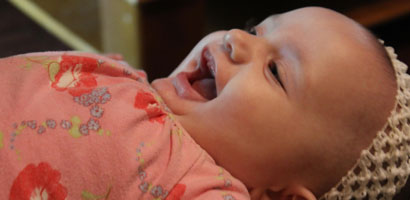 GREENSBORO — Donielle Wilde, her husband Keith and their 10 children know what it's like to receive a miracle ‒ well, two miracles, actually. One is a healthy little bundle of joy named Sylvia Hope, delivered via C-section after a harrowing pregnancy which was overshadowed by a cancer diagnosis. The other, they say, is a complete healing from that cancer.
GREENSBORO — Donielle Wilde, her husband Keith and their 10 children know what it's like to receive a miracle ‒ well, two miracles, actually. One is a healthy little bundle of joy named Sylvia Hope, delivered via C-section after a harrowing pregnancy which was overshadowed by a cancer diagnosis. The other, they say, is a complete healing from that cancer.
The Wilde family's ordeal began when Donielle was nine weeks pregnant. When she met with her obstetrician for a routine ultrasound, he noticed a 5-centimeter mass on her ovary that looked suspicious. Donielle underwent surgery to remove the stage IV tumor, which doctors said they might not have discovered if Donielle hadn't been pregnant.
"All went well," Donielle says, but doctor thought there was still a significant risk of cancer because the tumor turned out to be metastasized from breast cancer that Donielle had fought a decade ago. Her oncologist recommended that Donielle abort her unborn baby girl, then start aggressive chemotherapy to prevent the cancer from spreading further. The tumor, doctors told her, was growing fast, as her pregnant body was feeding the cancer.
Donielle and Keith flatly refused to have an abortion, and Donielle decided to put off chemotherapy until after the baby was born. It was a risky move, but they said they didn't want to put their unborn daughter in harm's way. Instead, they relied on their Catholic faith, praying for the strength to follow whatever would be God's will in their lives.
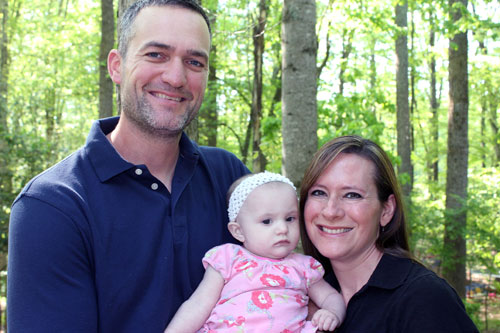 Keith and Donielle Wilde pose with their little miracle, Sylvia Hope; Pictured at top: A giggling Sylvia Hope on her father's lap. (Photos by SueAnn Howell | Catholic News Herald)"We felt like she was such a blessing, because if she wasn't there growing we would never have known the cancer was there," Donielle explains. "It could have easily killed me. I felt like she had saved my life, and it was my obligation to save hers.
Keith and Donielle Wilde pose with their little miracle, Sylvia Hope; Pictured at top: A giggling Sylvia Hope on her father's lap. (Photos by SueAnn Howell | Catholic News Herald)"We felt like she was such a blessing, because if she wasn't there growing we would never have known the cancer was there," Donielle explains. "It could have easily killed me. I felt like she had saved my life, and it was my obligation to save hers.
"I wanted to meet her – this beautiful child inside me."
The entire family eagerly awaited the arrival of Sylvia Hope, especially the Wildes' other nine children. "The children were all excited to have another sibling," Donielle recalls.
Prayer also helped Donielle through another challenge in her pregnancy: a large blood clot that broke up and went to both of her lungs.
"I didn't feel anything. I didn't have shortness of breath. I had no pain. I didn't know anything was happening," Donielle describes. "I credit that to the power of prayer. When we did find out that the clot was there, immediately people were praying for our situation."
After that, the rest of her pregnancy went perfectly, she says.
"It was a very joyous time for us with the anticipation of her arrival. I felt like it was one of my easiest pregnancies. I had so much energy! God really blessed us quite a bit."
Doctors continued to monitor her pregnancy, determined to deliver Sylvia Hope as soon as feasible so that Donielle could begin chemotherapy. On Nov. 6, 2014, Sylvia Hope was born via C-section, weighing 7 lbs., 1 oz.
"It was an incredible experience," she remembers. "I'd never had a C-Section. It felt like it was my first time having a baby – it was all different."
Her obstetrician Dr. Lewis Lipscomb, also a Catholic, led them in prayer before entering the delivery room, which Donielle says "just put all of us at such peace."
Donielle wore two religious medals during her pregnancy, one a third-class relic of St. Peregrine and another a second-class relic of St. Gianna Beretta Molla. She asked Lipscomb if he would put them in his pocket during surgery. "He said, 'No, I'm not going to put them in my pocket.' He then placed them around his neck. He handed me a wooden rosary, which was just so beautiful, (and) which I was able to hold during surgery."
The delivery room was crowded with medical staff "because of the uncertainty of the situation," she remembers, and she remained awake throughout the delivery.
"Sylvia came out perfect. There was nothing wrong with her," she says.
Donielle became a little concerned when she overheard Keith and others saying "I've never seen anything like this before!" But there was nothing wrong – it was just that Sylvia Hope was born already with a bottom tooth.
Immediately after the baby was born, doctors performed surgery to check for any cancer, and they removed one cancerous nodule, Donielle says.
"Nothing new grew during the pregnancy, which is extremely unusual," she says. "The cancer should have grown, it should have spread. Scientifically, everything was lined up for that to happen – and none of that happened."
Donielle recovered quickly from both surgeries, and on Nov. 21 returned to her oncologist.
He told her that tests had found no cancer. "You're grossly N.E.D.!" he said. N.E.D. stands for "no evidence of disease," doctors' shorthand for remission.
That, says Keith, "is really remarkable. It has to be one in a million, scientifically. We know in our hearts we were blessed with a great healing from God, no doubt about it."
Lipscomb is pleasantly surprised with how well Donielle is doing.
"It's quite encouraging that she has remained without evidence of disease," he says. "It's important we keep watching her closely in case she should show any signs of recurring disease. I do credit her speedy recovery and condition to her faith and her fervent prayer. She is a courageous woman.
"St. Gianna was someone that she asked for intercession during her pregnancy. It's no accident that she sought her intercession, as St. Gianna was faced with a similar situation in which she also had a tumor in her pregnancy and was told to abort her baby. Fortunately, her baby lived and has her life because of her mother's sacrifice.
"I think that paints a good picture of what Donielle did, too."
Their Catholic faith, Donielle and Keith both say, was instrumental throughout this challenge in their lives.
"The greatest gift I have ever received is my Catholic faith," Donielle says. "I thank my parents often for passing this faith down to me. Living out this love for my faith hasn't always been easy. I have learned it is only in cultivating it that brings about fruition. We must never stay idle, we must never be too busy to pray."
The family has always prayed together, particularly "morning and evening prayers together as a family which would always end with us consecrating ourselves to the Sacred Heart of Jesus and Immaculate Heart of Mary," she says, but at the start of Lent "we decided to 'kick it up a notch' by saying the rosary together every evening as part of our Lenten prayers. Even though it was often difficult to get through a rosary with nine children and the oldest was only 12, we persevered and it became easier."
After Lent they continued the nightly rosary and consecration, she says. "As our love for the Blessed Mother grew as a family, we felt the desire to show her our love in return. In May of 2014 I asked my parish priest if he could enroll our family in the brown scapular. He graciously said yes."
The Blessed Virgin Mary had helped lay a strong foundation for what they would have to face, Donielle says as she looks back on the past year. Their prayer life and reliance on the Blessed Virgin Mary helped propel them through the stage IV cancer diagnosis during her pregnancy, she says.
"We felt equipped and ready for anything. That grace and peace was bestowed upon our family through Our Lady of the Rosary and the brown scapular."
Donielle also credits her healing to the intercession of several saints, and the sacrament of anointing of the sick that she received from her priest.
"It is a tremendous blessing to be part of this Catholic faith that through the centuries has been enriched with these beautiful sacraments and sacramentals to help us along the way," she says.
Above all, she says, she and Keith are grateful for the prayers of so many people in North Carolina and around the country.
"It was extremely humbling. At first I felt uncomfortable asking for prayers because I know of many other people suffering or experiencing tragedy that I felt were more in need of prayer than me – as if I was using them all up.
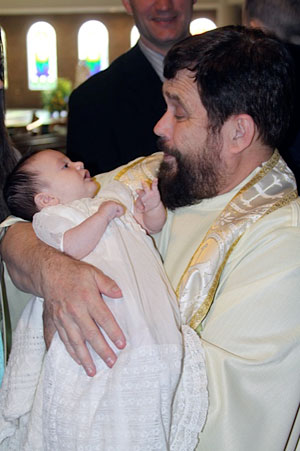 Sylvia and Father Joseph Mack at her baptism at St. Paul the Apostle Church in Greensboro. (Photo provided by Donielle Wilde)"Then once again I was humbled. One Sunday at Mass while reciting the Penitential Rite it struck me as we are all saying, 'brothers and sisters ... pray for me to the Lord our God.' There it was, right there in the Mass. That is the Universal Church in action. We are our brothers' keeper, we all need each other on this path to holiness."
Sylvia and Father Joseph Mack at her baptism at St. Paul the Apostle Church in Greensboro. (Photo provided by Donielle Wilde)"Then once again I was humbled. One Sunday at Mass while reciting the Penitential Rite it struck me as we are all saying, 'brothers and sisters ... pray for me to the Lord our God.' There it was, right there in the Mass. That is the Universal Church in action. We are our brothers' keeper, we all need each other on this path to holiness."
To all those who prayerfully accompanied them on their journey Donielle says, "Thank you from the bottom of our hearts for imitating Christ's love through your actions of prayer and sacrifice on our behalf."
Lipscomb asks everyone to keep Donielle in their prayers.
"Time will tell," he says. "There's always a chance of recurrence. That is why I continue to pray for Donielle and others should be encouraged to do so as well."
The Wildes view their ordeal not as a test of their faith, but as a way to unite their suffering to that of Jesus Christ on the cross.
"It is only through Him that you will be able to experience the joy of suffering and peace of the unknown," Donielle says. "I told my oncologists that if I made it through my pregnancy, I would do anything they recommended once Sylvia Hope was born. There was never a point that I felt fear.
"Often we need to step back and take a look at the situation we are facing with two sets of lenses: the natural and the spiritual. In my case, it was very easy to discern what to do when the other option was that of taking the life of my child. We need to remind ourselves that the devil wants us to be scared, fearful and in despair. We must rebuke those feelings by placing our trust in God.
"The things my oncologists had predicted to happen, such as an aggressive continued spread of cancer due to the pregnancy producing hormones acting like fertilizer to a plant, didn't happen, and no one knows why."
She adds, "I've come to the realization in my own heart that God wants to perform miracles. We just need to allow Him to do so, giving Him enough room to work and ridding ourselves of anything that is not of God, beginning with fear, anxiety and despair.
"God wants to restore order. We may not always understand His plan, but must trust and hope in difficult circumstances. Be at peace no matter what!"
— SueAnn Howell, senior reporter

